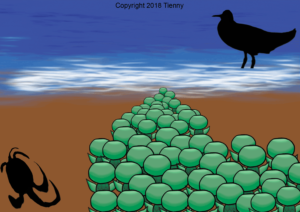In the birth of turtles research article, a mother turtle digs the sand. Then she lays 50 to 200 ping pong ball-shaped eggs and bury her eggs with her hind flippers. Finally, she returns to the sea.
It is interesting to study and observe turtles. Sea turtles know their own weaknesses. Cold-blooded sea animals. But blessed with great instincts. They have great determination and willingness to travel to meet their needs. The under the sun research article highlights the importance of sunbathing. The natural sun helps to increase their immune and digestive systems.
Likewise, mother turtle lets the sun to heat her buried eggs. She has full trust on the natural resources surrounding her. At the same time, she also ensure her hatchlings wellbeing by digging the sands.
Unlike humans, turtle eggs incubation takes about 60 days. The temperature of the sand governs the speed of the hatching process. For humans, the father determines the gender of the baby. But for turtles, the sand temperature determines the gender of the baby turtle. Cooler sand tend to produce more males but warmer sand produce more female.
Towards me, the baby turtles have many siblings hatch out together. They are able to enjoy each others’ company. This is their unique differences to human. Usually, humans give birth to one baby. Few humans give birth to twins and triplets.

Journey from Nest to Sea
I have been researching about turtles. The hatch out turtle eggs are like fraternal twins but born in different batch. That meet their first challenges together on their journey from nest to sea. Together they have to protect themselves from their land predators. The crabs and a flock of gulls. They return to the same sea as their mothers to prevent dehydration.
Thus, I conclude that turtles have their distinctive nature.

Comments are closed.